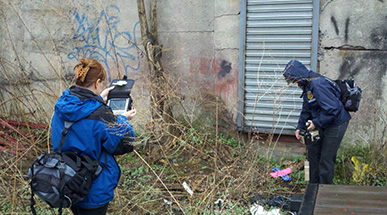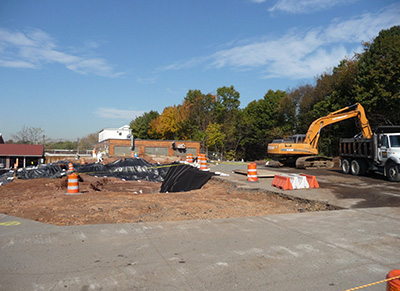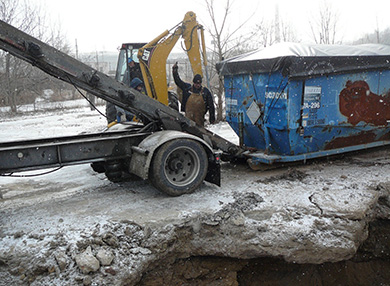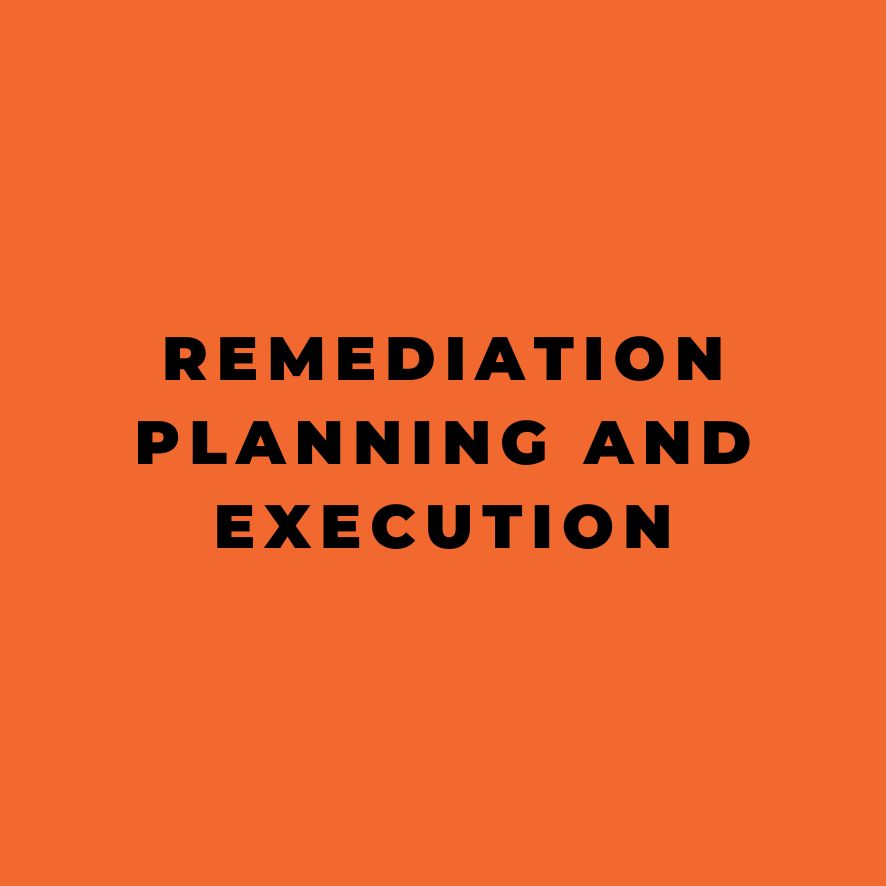Hey, Dr. Zoomie! I’ve got a bit of contamination I’m working with and my regulators are telling me I need to characterize the area before I start cleaning up and again when I think I’m done. I know they mean when they say “characterize” but I’m not quite sure what goes into a characterization plan. Can you shed some light? And what about the remediation – any tips on putting together a remediation plan and doing the cleanup?
As I mentioned in the last posting, this is a question that simply can’t be answered in a single, short post. And, in fact, I can’t even answer it thoroughly in two somewhat longer posts. So, as with the last one, what I can do here is to give a high-level overview of the subject – but you’re going to have to do a lot of reading and work on your own, or find a consultant who can help you with all of this, or maybe a combination of these.
What you need to do for this part of the cleanup effort is to develop a remediation plan to submit to the regulators, review their comments and suggestions, and come up with a revised plan that will accomplish what you need to do, hopefully at a cost you can live with, that will please the regulators, and will get the site cleaned up to your regulator’s satisfaction in a reasonable amount of time. And there are times when it’s just not possible to accomplish all of these simultaneously…or, rather, when some expectations might need to be adjusted.
The site characterization showed you how much contamination is present and where it’s at. What the remediation plan does is to describe what areas will be cleaned up and how that remediation will take place. And that means that you’ll need to describe how you’ll decide which areas need to be remediated, how that remediation will be performed, and how you’ll check to confirm that the remediation has been successful. If you can’t do all of these to the regulator’s satisfaction then they’ll likely want to see some changes to your remediation plan. Let’s look at these one at a time.
Which areas need to be remediated
The goal of a radiological remediation is to reduce radionuclide concentrations to the point at which radiation dose will no more than 15 mrem annually from the remaining radioactivity from all exposure pathways (e.g. inhalation, direct exposure, ingestion, and so forth). In many cases there are already guidelines for permissible soil contamination levels; in other cases you’ll need to do some calculations to show how much dose will result from the cleanup level you’re requesting.

One example of cleanup limits is Ra-226; there has been so much radium contamination from the Golden Age of Radium that we’ve developed some fairly solid cleanup limits – as long as it’s a straightforward case, simply cleaning up so that average Ra-226 concentrations are less than 5 pCi/gm greater than background in the top 15 cm of soil ought to do the trick. I’ve seen other cleanups in which the regulators had a further stipulation that concentrations be no more than 15 pCi/gm above background between 15-30 cm depth – since the Ra-226 is part of the naturally occurring U-238 decay series it’s regulated by a combination of the states, the EPA, and (to a lesser extent) the NRC, so setting cleanup limits is often the result of negotiations between the licensee, various regulatory bodies, and other affected agencies. The most convoluted I’ve had to work within was for a radium-contaminated site in Illinois; this was some time ago and the NRC wasn’t involved, but the US EPA and Illinois regulators were, as well as the Army Corps of Engineers, who was managing the excavations.
If you’re not dealing with a radionuclide for which there’s a defined cleanup limit then things can get a little more interesting, primarily because for any given concentration of any given radionuclide the calculated radiation exposure depends on how that land is going to be used. The biggest variable is how many hours annually you feel that people will be exposed to the radiation on that site.
For example, when I was in Japan after the Fukushima accident, the highest dose rate I measured was about 0.5 mR/hr. This means that a person standing at that location for 30 hours would receive 15 mrem, and a person who spent 100% of their time on that spot would receive an exposure of just under 4400 mrem in a year. But what if that location was in a front yard? It’s fairly easy to come up with scenarios in which a person could spend 30 hours annually; gardening and lawn care could do the trick in just a single weekend. But it’s also easy to come up with scenarios in which nobody is likely to spend that much time on that location – in the middle of an airport runway, for example.
The place where I made that measurement was in a parking lot – there, it would be easy to assume that employees responsible for keeping the parking lot free of litter might well exceed 30 hours (and 15 mrem) annually, but it’s also easy to assume that no customer would even come close. And if the parking lot were used primarily by commuters (at a train station, for example) it might be reasonable to assume that nobody would exceed a dose of 15 mrem annually.
But things can be more complex. A family might have a garden in contaminated soil, requiring calculation of the amount of radionuclide that ends up in their salads and veggies. On a farm, the family cow might eat contaminated grass and transfer radioactivity to the family via contaminated milk and/or meat. One of the decay products of uranium is radon, so if the site is contaminated with uranium then we need to consider dose from radon inhalation. And so forth. Bringing this back to your site – if what you’ve got is, say, a contaminated warehouse then developing a cleanup limit is pretty simple; if it’s a contaminated neighborhood, things are much more complex. The more complicated the situation, the more likely it is that you’ll need to use software such as RESRAD rather than referring to tables in Federal Guidance Report 15. But the bottom line is that, once you determine your cleanup limit, you’ll know what needs to be remediated – any areas that are in excess of that limit.
How the remediation will be performed
This part is usually pretty simple – contaminated surfaces are typically remediated by wiping them down with soap and water, some sort of cleaning agent designed for radioactive materials, steam cleaning, or something along those lines. If the radioactivity has soaked into a floor or wall (for example) then steam cleaning, scabbling, or cutting out a chunk of the floor or wall will often do the trick – although strippable coatings are sometimes useful as well. And if it’s the soil that’s contaminated, often the easiest solution is to just excavate the contaminated soil, pack it into bags, boxes, or drums, and ship it to a radioactive waste site for burial. You’ll also need to include some bread-and-butter stuff – your ALARA plan, protective equipment (e.g. respiratory protection if it’s possible to produce airborne radioactivity, coveralls and gloves to reduce the chance of skin contamination, performing radiation surveys, and that sort of thing).

And you’ll also need to explain how the workers will know to stop digging (or scrubbing, or cleaning up in general); otherwise you run the risk of “cleaning up” long after all of the contamination is gone, which bumps the cost way up as well as adding risk to the folks who are doing the work. If you’re cleaning up a room contaminated with Cs-137 (for example)then your remediation plan might say that you’ll wipe down the area, surveying with a GM pancake probe from time to time, until you reach a reading of 100 cpm above background count rate or until the count rate stops dropping, indicating that the remaining contamination is fixed. If you’re remediating soil contamination then you might, instead, say that soil will be excavated in 1-m lifts, followed by surveying the exposed surface and repeating if the count and/or dose rates are less than twice as high as background levels; when a soil sample will be sent for analysis. The bottom line is that the people doing the work need to know when to stop cleaning and how to confirm that the contamination is really down to acceptable levels.
As an aside, be aware that soils and the rocks from which they’re formed contain potassium, a small fraction of which is radioactive K-40. So if you excavate into, say, a clay layer comprised of high-potassium clays then your readings might not drop to your target levels, forcing you to continue “remediating” soil that’s uncontaminated.

This happened on one radium remediation project I worked on a while back – the site manager said that the soil they were removing was neither disturbed nor discolored, yet they continued getting readings just above the criteria for stopping. I asked if they’d dug into a clay layer and, when told yes, I suggested checking for K-40. It turned out that all of the extra counts were due to natural potassium from the clays; this was confirmed by a lab analysis and we were able to stop excavating and move on to the next site.
Checking to confirm remediation was successful
This is the fun part! You’ve already planned and performed one characterization survey – now you just need to do a smaller one since you’re primarily checking the places you remediated to confirm that you met the cleanup goals. Then you (or your consultant) will write up the survey and send it off to the regulators for their review and (hopefully) approval. Easy-peasy!
Finally – this can all be a long and drawn-out process. The easiest characterization and remediation I was involved in took over a year from the time I started working on the first piece of paperwork until the waste was shipped for disposal, and there were another several months of follow-on work and reports to regulators (plus answering their questions) after that. And that was an easy one! Having said that, cleaning up interior spaces could be fairly straightforward or really complex or anything in between. In general, though, if you’re trying to decommission a space to get it released for unrestricted use it’s going to take longer and be more involved than if you’re just cleaning up a spill. Either way, though, if you go through the process, if you’re able to work with your regulators, and if you use all the materials and other resources that are available to you (including consultants if things are complicated) then you’ll be able to work your way through and get your site released. Yay!
